You now have a general idea of how to navigate Mexico City and two itineraries (Day 1: Chapultepec and Day 2: Coyoacán) to choose from so that you take advantage of the extra days you may have after a business trip.
As I said before, Mexico City is a vast and complex city, but you don’t need to worry about that, because I’ve written this series to make it very simple for you.
You tackle the city by neighborhoods and today we’re going to speak about one of the most important: Cuauhtémoc.
Day 3 in Mexico City: Cuauhtémoc
The neighborhood of Cuauhtémoc is a large area that contains the historical center of the city, albeit it is not the geographical center.
Nevertheless, it is in Colonia Centro (historical center) where the majority of today’s attractions are.
When referring to Cuauhtémoc you need to remember that inside it, there is also the Colonia Cuauhtémoc, a residential area.
Colonias are neighborhoods inside each of the 16 Mexico City’s boroughs. Our first stop, Plaza de la Constitución, El Zócalo.
Plaza de la Constitución, El Zócalo
The Zócalo is the main square in Mexico City and it is one of the largest plazas in the world. The Mexican flag in its middle is also humongous!
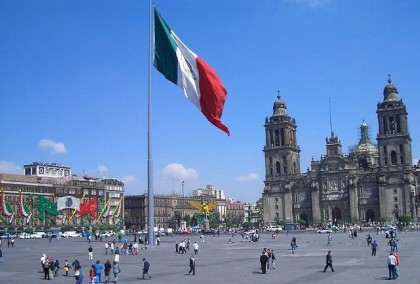
Plaza de la Constitución El Zócalo. Photo: Wikipedia, schlaeger.
Please copy and paste the following link to go to the original image:
http://commons.wikimedia.org/wiki/File:Plaza_de_la_Constitucion_Ciudad_de_Mexico_City.jpg
The square is surrounded by several important buildings like the Palacio de Correos de Mexico (Postal Palace of Mexico City) and a few others I’ll cover in a minute.
In the 15th century the Zócalo was an open space in the middle of the old city of Tenochtitlan, the Aztec capital. But Tenochtitlan will have to be the subject of a future, more in-depth post.
Place yourself in the middle of the square and go through the buildings as follows.
Palacio Nacional
The National Palace is the seat of the President of Mexico and government offices. It has been the place where the rulers of Mexico have lived since the time of the Aztec empire.
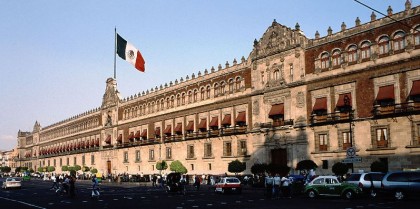
National Palace. Photo: Wikipedia, Reinhard Jahn, Mannheim.
Please copy and paste the following link to go to the original image:
http://commons.wikimedia.org/wiki/File:MexCity-palacio.jpg
Some of the original materials of Moctezuma II’s palace are still there. There is so much history in this place. But for this article we’re going to talk about art.
Yes, artist Diego Rivera (remember him?) was commissioned the task of adorning the main stairwell and the walls of the second floor from 1929 to 1935.
The muralist painted some of his most iconographic frescoes depicting the history of Mexico from 1521 to 1930.
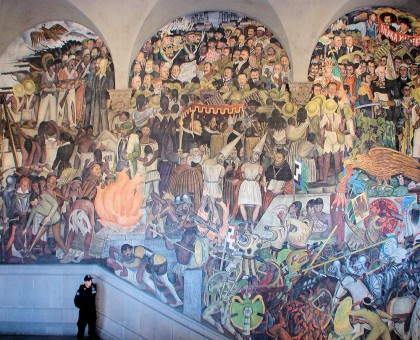
Diego Rivera’s Mural Depicting Mexico’s History. Photo: www.delange.org
The magnificently epic murals show everything from the old city of Tenochtitlan through the conquest by the Spaniards and his own political views.

Diego Rivera’s The Legend of Quetzalcoatl. Photo: www.delange.org
The murals merit a few posts about them, they’re so intricate and detailed. Also, definitely very hard to photograph, though the website delange.org gives it a pretty good shot.
If you’re an art lover and you want to see the murals, I suggest you read about them extensively and once you’re there, spend time really seeing them in detail, because they are masterpieces, indeed.
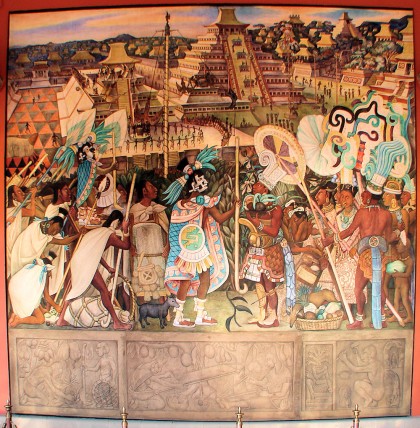
Diego Rivera’s Totonac Civilization, El Tajin. Photo: www.delange.org
A tip, try to find Frida in the murals, she does make a few appearances, as well as her sister Cristina.
Go out of the National Palace and turn right to find the next stop.
Excavations of the Templo Mayor
The archaeological site of the Templo Mayor is located to the north of the National Palace. They’re what remains of the main temple of the city of Tenochtitlan and is part of the UNESCO World Heritage List.
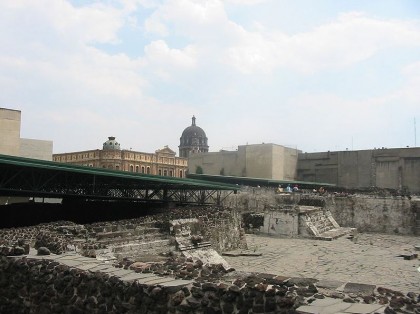
View of Eagle building and building A in the Templo Mayor complex. The ruins of the main temple are in the background. Photo: Wikipedia, Thelmadatter.
The temple was built in the 14th century but in 1521 the city was destroyed by the Spaniards, who then built upon it.
It was in the 20th century that the temple complex was re-discovered and excavations begun.
The temple was dedicated to both Huitzilopochtli, god of war and Tlaloc, god of rain and agriculture. At the top of the temple pyramid there was a shrine for each with a staircase.
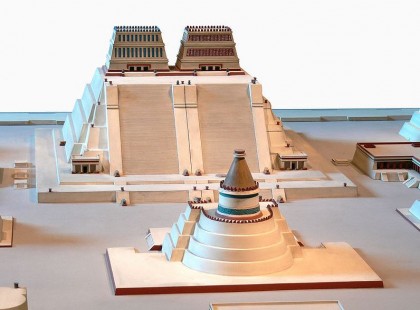
Scale model of the Templo Mayor. Photo: Wikipedia, Wolfgang Sauber derivative work: Joyborg (talk).
Please copy and paste the following link to go to the original image:
http://en.wikipedia.org/wiki/File:Rekonstruktion_Tempelbezirk_von_Tenochtitlan_2_Templo_Mayor_3.jpg
Now walk half a block west to find the Metropolitan Cathedral.
Catedral Metropolitana
The construction of the Metropolitan Cathedral of Mexico City lasted more than two centuries from 1573 to 1813, thus combining elements of the Renaissance, Baroque and Neo-classic styles.
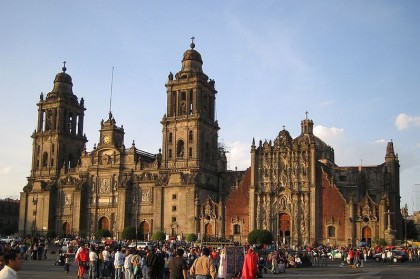
Metropolitan Cathedral. Photo: Wikipedia, Andre Engels.
Please copy and paste the following link to go to the original image:
http://en.wikipedia.org/wiki/File:Zocalo_cathedral.jpg
It was commissioned by Hernán Cortés to be built over the former Templo Mayor of the Aztec city of Tenochtitlan, using the later’s stones, so it’s quite old and a brutal reminder of Spanish conquest.
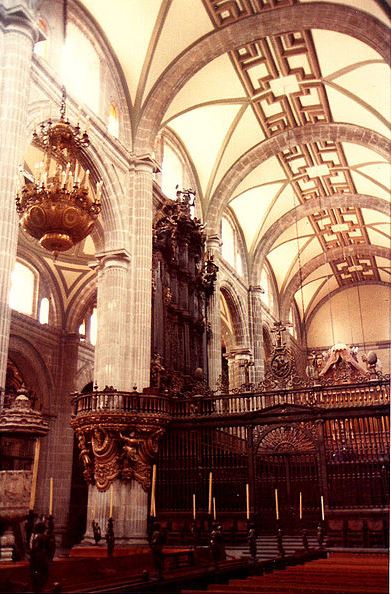
Interior of the Metropolitan Cathedral. Photo: Wikipedia, © by James G. Howes, 1987.
Please copy and paste the following link to go to the original image:
http://en.wikipedia.org/wiki/File:Mexico_DF_Cathedral.jpg
This cathedral is an amazing work of art with elements from several styles, even if the soft soil in which it stands has caused it severe damage.
Madero Street
On the west side of the Zócalo, find Madero Street, a pedestrian area with European architecture and plenty of opportunities for shopping.
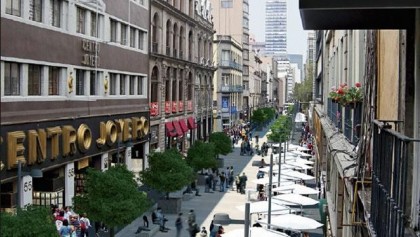
Calle Madero. Photo: mexico.cnn.com
Walk about seven blocks west on Madero Street until you reach the Eje Central Lázaro Cárdenas Street and then you’ll see it.
Palacio de Bellas Artes
The Palace of Fine Arts is the home of the National Institute of Fine Arts of Mexico. It is the most important cultural center in Mexico City.
From the architecture, murals, ballet, theater and other artistic forms, the Palace of Fine Arts is one of the most beautiful places in the city.
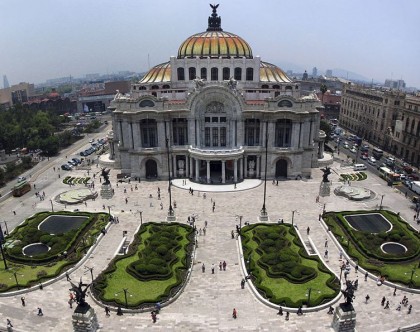
Palacio de Bellas Artes, exterior. Photo: Wikipedia, Carolina López.
Please copy and paste the following link to go to the original image:
http://en.wikipedia.org/wiki/File:Palacio_de_Bellas_Artes.jpg
The building we see today was finished in 1934, even though the area has been excavated for archaeological finds and even a convent stood there once.
The original idea for the Palace originated in 1904 but due to design problems, the soil being too soft and political turmoil the construction was delayed until the 1930’s when it was re-designed and finally built.
The architecture of the building is astonishing with Art Nouveau on the exterior and Art Deco in the interior paired with Aztec elements.
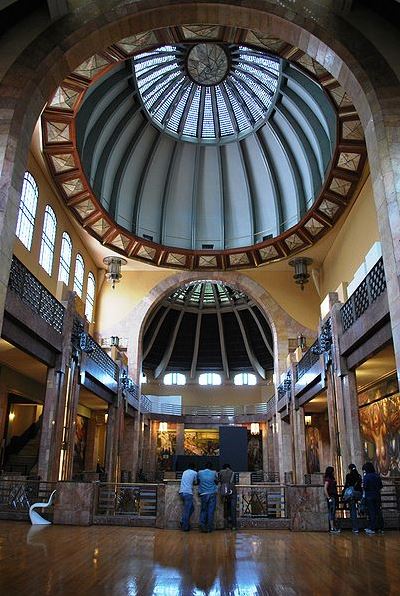
Palacio de Bellas Artes, interior. Photo: Wikipedia, AlejandroLinaresGarcia.
Please copy and paste the following link to go to the original image:
http://www.culturaltravelguide.com/wp-content/uploads/2013/04/mexico-city-palacio-de-bellas-interior.jpg
There are many famous murals by Diego Rivera, Siqueiros and other artists that cover its walls. One of the most intriguing Man, Controller of the Universe by Rivera.
This particular mural is a smaller scale version of the one commissioned by Nelson Rockefeller for the ground-floor wall of Rockefeller Center which was destroyed when Rivera refused to remove the image of Lenin.
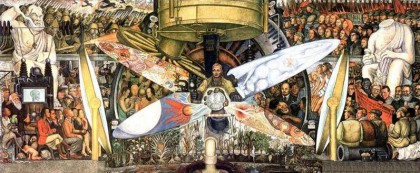
Man, Controller of the Universe by Diego Rivera. Photo: reaviewmirror.blogspot.com
The Palacio de Bellas Artes is one of the finest examples of art and architecture in the Americas and truly a must-see when going to Mexico City. Definitely one of my very favorite spots.
If you can, I highly recommend you attend a presentation of the Ballet Folklorico de Mexico.
Now, walk five blocks north to find Plaza Garibaldi.
Plaza Garibaldi
Now to finish the day unwind, relax and possibly enjoy a few tequilas, visit Garibaldi Square, the mariachi mecca.
If you want to see what Mexico is all about, Plaza Garibaldi is one of the top places. There are mariachi bands available 24/7 for your listening pleasure.
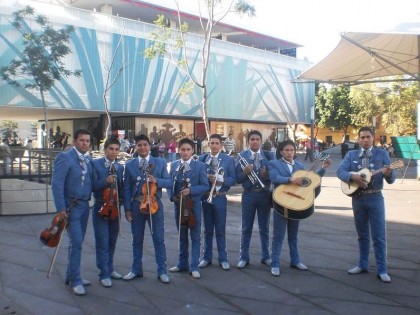
Mariachis at Plaza Garibaldi. Photo: Wikipedia, EpMe.
Please copy and paste the following link to go to the original image:
http://commons.wikimedia.org/wiki/File:Mariachien_en_Plaza_Garibaldi.jpg
Plus many bars and taverns where you can get a taste of delicious Mexican drinks and coctails or just go directly to the Museum of Tequila and Mezcal (Yes, they have a museum! Mezcal is the one with the worm).
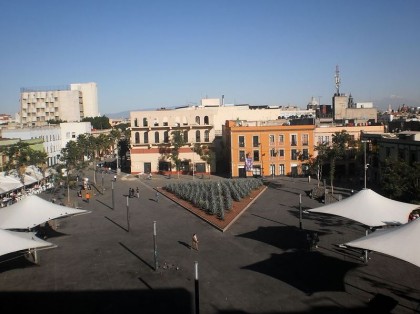
Plaza Garibaldi. Photo: Wikipedia, EpMe.
Please copy and paste the following link to go to the original image:
http://commons.wikimedia.org/wiki/File:Plaza_Garibaldi.jpg
So that’s it for our day at Cuauhtémoc, the historical center of Mexico City! We saw it all, didn’t we? Art, architecture, history, archaeology, music and yes, we got ourselves a bit tipsy too!
How about you? Which of these places excites you the most?
Share your comments in the field below or join the conversation in Facebook!
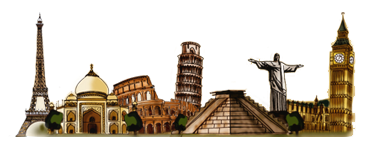


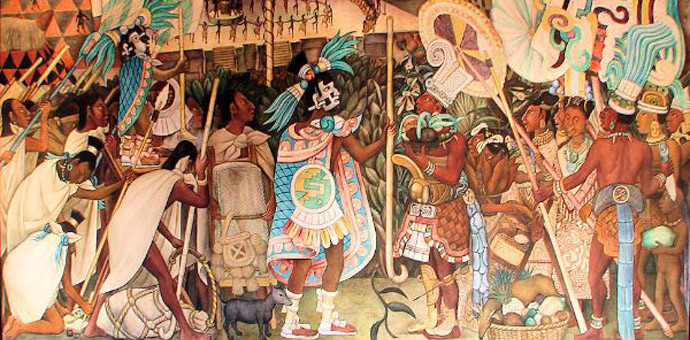

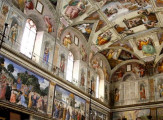
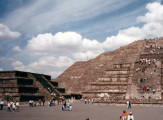
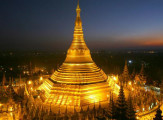
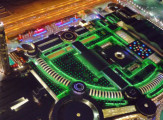
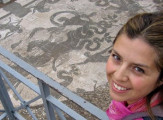
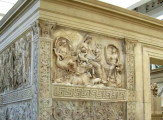
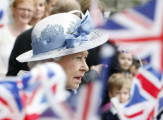
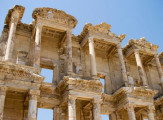


















Leave a Comment
Want to join the discussion?Feel free to contribute!